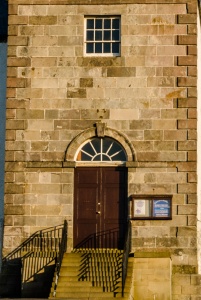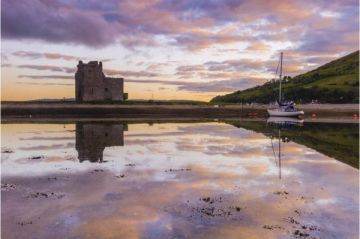
Islay has a wealth of historic churches and chapels, most of them ruined, but the most famous historic church is one of the most modern. At the top of Main Street in Bowmore, looking down to Loch Indaal, is Kilarrow Parish Church, more popularly known as Bowmore Round Church.
The Round Church was built in 1767 to a very unusual circular design; the only completely circular church in Scotland. The roof is supported on a single, central pillar of oak, some 19 inches in diameter and styled in the Tuscan order. The oak pillar stands on a sandstone base and supports a king-truss roof truss with 8 radiating beams to spread the load.
The unusual round shape is said to have been designed so there would be no corners for the devil to hide in. The exterior is 60 feet across, and the walls an impressive 2'9" thick.
Facing down Main Street is the striking tower, rising in four stages. On the second stage are square, blank panels, probably designed to take clock faces, which were never installed. The top 2 stages are octagonal, and pierced with sound-holes. The belfry is surmounted by a stone cupola. in the porch are a pair of monuments to the Campbells of Shawfield and Islay.

Origins
In 1726 Daniel Campbell, a descendant of Archibald, 2nd Earl of Argyle, purchased the lordship of Islay from Sir John Campbell of Cawdor for a sum of £12,000. Campbell's son John predeceased him, so when Daniel died in 1753 his 16-year-old grandson, also named Daniel, inherited the entire island of Islay.
Daniel Campbell the Younger created the first planned village in Scotland at Bowmore as part of a scheme to resettle villagers from Killarrow, near his home of Islay House. Campbell planned to extend the grounds of Islay House, and the village was in the way. By creating the new village of Bowmore he also hoped to generate extra rental income.
Who was the architect?
This is a vexing question, and the answer seems unclear. It is possible that Campbell met a French architect while on a Grand Tour of Europe. Certainly, the round design is more common in Europe than it is in Scotland.
Another possibility is that the initial design was by John Adam, brother of architect Robert Adam. Adam designed a round church for the 3rd Duke of Argyll at Inveraray. However, the Inveraray church was never built, as the circular shape could not easily be divided to allow services in both English and Gaelic.

Campbell was acquainted with the Duke of Argyll, and it is not a stretch of the imagination to think that he re-used Adam's design at Bowmore. It also seems that Campbell was inspired by hilltop villages in Italy, where churches set atop the hill served as the focal point for the entire village. He determined to locate his new church in a prominent position overlooking Loch Indaal, where it would dominate the new village of Bowmore.
While we don't know who designed the church we do know who actually built it. The contractor in charge of erecting the church was Thomas Spalding. The total cost of the building was £1000.
Over the neo-classical entrance is a plaque inscribed with a Latin verse which translates as,
"With pious intent, and to promote truth and honour, Daniel Campbell, lord of this island, built at his own expense in the year 1767, this church dedicated to the supreme God".
The church interior has a west gallery added in 1830, supported on 8 pillars designed to look like the central pillar, and a late 19th-century organ. There are several memorials to Campbell family members, including a touching monument to Margaret Campbell, an infant daughter of Walter Campbell, who died in 1822.
Within the church are mementoes connected with Rev Donald Caskie, the son of a crofter, born in Bowmore in 1902. Caskie served as minister at The Scots Kirk in Paris from 1938 and is known as 'The Tartan Pimpernel' for his role in helping over 2,000 Allied servicemen escape from German-occupied France during World War Two.
The Round Church is a destination on the St Columba Pilgrim Journey, linking sacred sites in Argyll and the Highlands.
NOTE
Because Islay is an island the 'nearest accommodation' properties listed below may not be on Islay itself but on the Scottish mainland. The best source we have found for accommodation on the island is Isle of Islay.com, a dedicated local website offering a wonderful mix of local information, history, activities, and accommodation information.
About Bowmore Round Church
Address: Main Street,
Bowmore,
Islay,
Argyll and Bute,
Scotland, PA43 7JH
Attraction Type: Historic Church
Location: At the top of Main Street (A846) in Bowmore. Parking along nearby streets.
Website: Bowmore Round Church
Location
map
OS: NR311596
Photo Credit: David Ross and Britain Express
POPULAR POSTS
HERITAGE
 We've 'tagged' this attraction information to help you find related historic attractions and learn more about major time periods mentioned.
We've 'tagged' this attraction information to help you find related historic attractions and learn more about major time periods mentioned.
Find other attractions tagged with:
NEARBY HISTORIC ATTRACTIONS
Heritage Rated from 1- 5 (low to exceptional) on historic interest
Museum of Islay Life - 3.6 miles (Museum) ![]()
Dun Nosebridge - 3.7 miles (Prehistoric Site) ![]()
Loch Gruinart RSPB Nature Reserve - 5.3 miles (Countryside) ![]()
Kilmeny Old Parish Church - 5.9 miles (Historic Church) ![]()
Nerabus Chapel and Carved Stones - 6.1 miles (Historic Church) ![]()
Kilchoman Crosses and Old Church - 6.3 miles (Historic Church) ![]()
Kilchiaran Chapel and Cup Stone - 6.6 miles (Historic Church) ![]()
Cultoon Stone Circle - 7.4 miles (Prehistoric Site) ![]()
Nearest Holiday Cottages to Bowmore Round Church:
Nearby accommodation is calculated 'as the crow flies' from Bowmore Round Church. 'Nearest' may involve a long drive up and down glens or, if you are near the coast, may include a ferry ride! Please check the property map to make sure the location is right for you.
Lochgilphead, Strathclyde
Sleeps: 4
Stay from: £405 - 686
More self catering near Bowmore Round Church






